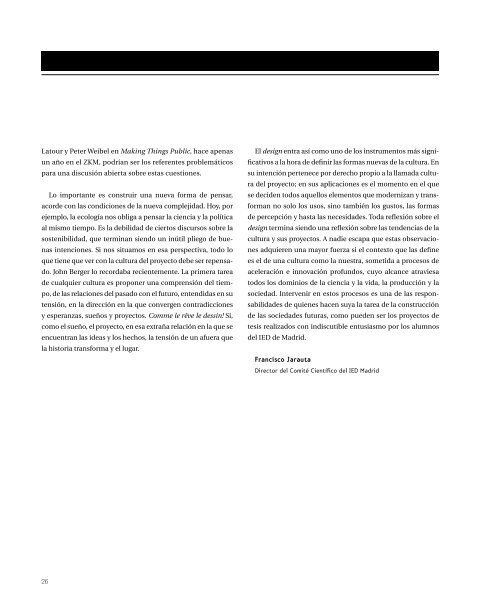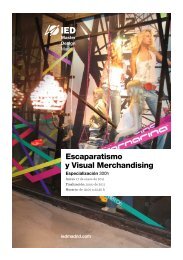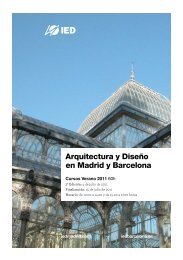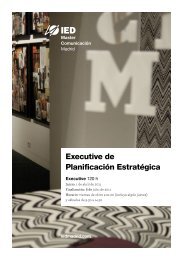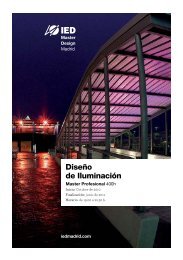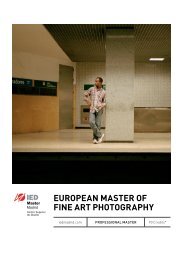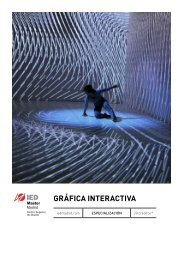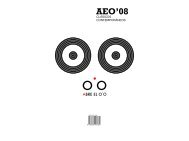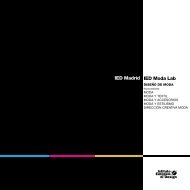nuevos valores del diseño new design values - IED Madrid
nuevos valores del diseño new design values - IED Madrid
nuevos valores del diseño new design values - IED Madrid
You also want an ePaper? Increase the reach of your titles
YUMPU automatically turns print PDFs into web optimized ePapers that Google loves.
V<br />
Imagining the Future<br />
Latour y Peter Weibel en Making Things Public, hace apenas<br />
un año en el ZKM, podrían ser los referentes problemáticos<br />
para una discusión abierta sobre estas cuestiones.<br />
Lo importante es construir una nueva forma de pensar,<br />
acorde con las condiciones de la nueva complejidad. Hoy, por<br />
ejemplo, la ecología nos obliga a pensar la ciencia y la política<br />
al mismo tiempo. Es la debilidad de ciertos discursos sobre la<br />
sostenibilidad, que terminan siendo un inútil pliego de buenas<br />
intenciones. Si nos situamos en esa perspectiva, todo lo<br />
que tiene que ver con la cultura <strong>del</strong> proyecto debe ser repensado.<br />
John Berger lo recordaba recientemente. La primera tarea<br />
de cualquier cultura es proponer una comprensión <strong>del</strong> tiempo,<br />
de las relaciones <strong>del</strong> pasado con el futuro, entendidas en su<br />
tensión, en la dirección en la que convergen contradicciones<br />
y esperanzas, sueños y proyectos. Comme le rêve le dessin! Sí,<br />
como el sueño, el proyecto, en esa extraña relación en la que se<br />
encuentran las ideas y los hechos, la tensión de un afuera que<br />
la historia transforma y el lugar.<br />
El <strong>design</strong> entra así como uno de los instrumentos más significativos<br />
a la hora de definir las formas nuevas de la cultura. En<br />
su intención pertenece por derecho propio a la llamada cultura<br />
<strong>del</strong> proyecto; en sus aplicaciones es el momento en el que<br />
se deciden todos aquellos elementos que modernizan y transforman<br />
no solo los usos, sino también los gustos, las formas<br />
de percepción y hasta las necesidades. Toda reflexión sobre el<br />
<strong>design</strong> termina siendo una reflexión sobre las tendencias de la<br />
cultura y sus proyectos. A nadie escapa que estas observaciones<br />
adquieren una mayor fuerza si el contexto que las define<br />
es el de una cultura como la nuestra, sometida a procesos de<br />
aceleración e innovación profundos, cuyo alcance atraviesa<br />
todos los dominios de la ciencia y la vida, la producción y la<br />
sociedad. Intervenir en estos procesos es una de las responsabilidades<br />
de quienes hacen suya la tarea de la construcción<br />
de las sociedades futuras, como pueden ser los proyectos de<br />
tesis realizados con indiscutible entusiasmo por los alumnos<br />
<strong>del</strong> <strong>IED</strong> de <strong>Madrid</strong>.<br />
Francisco Jarauta<br />
Director <strong>del</strong> Comité Científico <strong>del</strong> <strong>IED</strong> <strong>Madrid</strong><br />
Design has never had an autonomous history. It has always<br />
been considered as part of industrial culture or as a social ornament<br />
or an odd aspect of the history of customs. Norbert<br />
Elias recalls the fascination aroused by visiting and discovering<br />
all those collections of objects made during the second half<br />
of the 19th century, which eventually configured the world of<br />
the metropolis and its lifestyles, as described on the pages of<br />
the great realist novels. This fascination grows if the viewer’s<br />
gaze or curiosity takes him through industrial spaces, <strong>new</strong> machines<br />
and objects, and materials whose shine, in the case of<br />
German steel in the 1920s, trapped the retinas of the photographers<br />
employed by Fritz Lang.<br />
In a perfectly articulated sequence, which cultural sociology<br />
can reconstruct, lie the different stages of a process which,<br />
driven by the impulse set in motion by the Industrial Revolution,<br />
went on to be defined in the specific forms of objects<br />
from domestic and public life, with a coherence in consonance<br />
with the style of a historical period. The Modern Movement<br />
lived off this idea by claiming as its own the building project<br />
for a <strong>new</strong> cultural system in which the relationship between<br />
<strong>design</strong>, architecture and urban planning combined to form a<br />
logic or an idea which many of the movement’s representatives<br />
believed to be ethical. I am thinking of Walter Gropius and<br />
Bauhaus, to test this attitude and way of thinking when faced<br />
with the cost of projectual culture. Although it is true that the<br />
only proposal by the Modern Movement, based on a rigid hierarchy<br />
of decision making, imploded quite a while ago, leaving<br />
an open space for conflict between the three disciplines<br />
which, as of today, after a thrilling period of agreements and<br />
disagreements, is again taking place in different contexts, such<br />
as those derived from post-industrial societies, built on the<br />
foundations of a growing complexity, which simultaneously<br />
enjoys <strong>new</strong> technological possibilities which allow for hitherto<br />
unheard-of innovation.<br />
On the basis of this complexity, it can be observed that, over<br />
the last few years, a progressive expansion of the theoretical<br />
and operative field of <strong>design</strong> has taken place. Its programmes<br />
have come to be defined from the perspective of a permeable<br />
relationship with the great transformations in the life systems<br />
of post-industrial society, which are mainly defined by cultural<br />
standardisation and production internationalisation. It is essential<br />
to keep in mind that the stages of increasing globalisation<br />
must not be viewed only from economic and political<br />
perspectives, but that, finally, cultural aspects also define the<br />
true field of effects. After communications and the market<br />
–the two true agents in the globalisation process– it is necessary<br />
to mention the generalisation of cultural patterns which<br />
eventually define <strong>new</strong> mo<strong>del</strong>s of symbolic frames of reference,<br />
around which are articulated the processes of identity and difference<br />
of the contemporary world.<br />
Indeed, these problematic contexts are the focus of debate<br />
in the current projectual culture. When it comes to responding<br />
to the demand for <strong>new</strong> ways of living, we again come up<br />
against the two main traditions of the 20th century: a universalism<br />
which the Modern Movement postulated as a strategy<br />
to achieve a <strong>new</strong> form of culture which would be valid for all;<br />
and a position which found the freedom of games and proposals<br />
in the experiments of post-modern culture, and was legitimised<br />
by a culture dominated by the privilege of individualism<br />
and a vague aesthetization of life. Certainly, nowadays those<br />
experiments seem to us as distant as the 1980s. But this was<br />
not the case with all that took place during the so-called “radical<br />
movement” of the 1970s, which directly shook the theoretical<br />
and moral conventions of the time, giving rise to a debate<br />
whose main achievement was to open the way to <strong>new</strong> critical<br />
perspectives which still address the basic problems of the projectual<br />
culture.<br />
We may have to go back to these ideas in order to establish<br />
a dialogue with its limitations and lacks. It is a question of recognising<br />
an initial complexity in which all the variables underlying<br />
the project come together. Robert Venturi admitted it<br />
when he spoke of these difficulties. According to him, “Mod-<br />
26 27


